Shaping and Solidifying Foams
After the foams have been created, several processing methods can be used to shape and solidify the foams into useful products. The pressures normally involved in all these processes are relatively low since high pressures would likely cause the foam bubbles to collapse and destroy the foam. The low pressures allow the use of low-cost molds or other shaping devices, as is the case with other low-pressure plastic-molding methods. Some foams are shaped and solidified without external heat. This low-temperature foaming capability gives additional latitude in the choice of mold material and construction. Foam molds can, therefore, be made from a wide variety of materials, including metals, wood, rigid plastics, and elastomers. As previously noted, foams can be either flexible or rigid. The flexibility of foams also tude in molding and shaping since undercuts and other fairly complex and difficult-to-mold shapes can be extracted (stripped) from the molds without the need of complicated slides or removable cores.
Each of the major shaping and solidifying processes can be used with any of the foam-creating processes previously described. These foam-creating processes can be used both with thermoplastics that are melted, foamed, and then cooled to solidify, and with liquid thermosets that are foamed and then crosslinked to harden. In discussing these shaping processes, the term resin will be used to include the resin itself and any filler, solvent, initiator, or other additive that might determine the specific properties of the product. The presence of a foaming or blowing agent will be specifically noted since the time for adding that agent may be determined by the shaping process.
The processing methods to shape foams differ fundamentally in the manner in which the foamed materials are introduced into the molds or other shaping devices. They also differ in the manner in which the foaming process is controlled.
17.3.1. Molding
Foamed liquid materials can be injected or poured directly into molds that define the shape of the product after solidification. Two somewhat different methods are used to control the manner in which the foam expands within the mold. In the first method, called low-pressure foam molding, a metered volume of liquid resin containing the foaming agent is introduced into the mold. The volume of this as yet unfoamed or partially foamed material is much less than the volume of the mold, but it is soon allowed to expand to fill the mold. The trigger for initiation of the foaming action can be a reduction of pressure when the material is introduced into the open mold, much like the foaming of materials that occurs when the materials are released from a pressurized can (such as shaving creams, whipped cream, and stop-leak agents for tires), or it can be an increase in temperature if the mold is heated. The type of triggering action depends on the type of foaming agent used. Expansion of the material takes place because the foaming agent creates bubbles within the liquid resin that cause the volume of the resin to expand (see Figure 17.1). This expansion is limited by the size of the mold and is called low-pressure foam molding because the expansion occurs against no external pressure. The expansion process itself may create a slight pressure, but it is trivial.

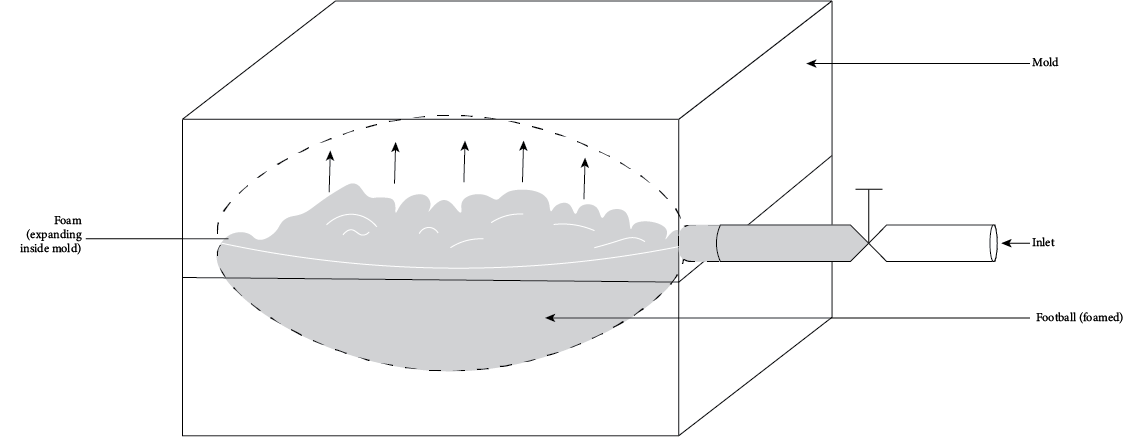
Figure 17.1 Low-pressure foam molding.
The other method of controlling the expansion of the foam in the mold involves expansion against an external pressure. Hence, this method is called high-pressure foam molding. It is important to note that even though the process is called highpressure, the pressures are high only in comparison with the essentially zero pressure of lowpressure foam molding and are not high when compared to plastic-molding methods such as extrusion and injection molding. In high-pressure foam molding, the liquid resin with foaming agent is introduced into a mold is mechanically expanded at a set rate as the foaming occurs. The expanding cavity controls the amount of foaming that occurs and therefore determines the density (volume and amount of foaming) of the foam. This process is shown in Figure 17.2.
The types of products made by the two foam molding processes can be quite different. The low-pressure process tends to create open-cell foams, whereas the high-pressure process creates predominately closed-cell foams. Under certain conditions, however, closed-cell foams can be made by the low-pressure method and open-cell foams can be made by the high-pressure method. For instance, if the expansion of the mold during the high-pressure foam molding process is quite rapid, the cell structure may convert from closed cells to open cells. This event, known as "blowing the cells open," can be a problem when closed-cell foams are desired. The variance in molding conditions that will change a closed-cell foam into an open-cell foam can be very slight, perhaps only a few degrees’ difference in the temperature of the liquid or a slightly faster expansion speed in the mold. In both molding processes the cells that touch the walls of the mold and some of the cells just inside these outer cells collapse and form a nonfoamed plastic coating, or integral skin. The thickness of this skin is determined by the amount of material introduced into the mold, the temperature during molding, the nature of the mold surface, the presence of mold release, and the pressure during the expansion process. The type of foaming agent used can also affect the thickness. Integral skins also form around inserts placed within the molds. Integral skins affect several important properties of foams. For instance, the permeation of a liquid or a gas through the skin is much lower than would occur through the remainder of the foam, especially in open-cell foams. The integral skin increases the strength of the foam. This feature of integral-skinned foams is used, for example, to limit the indentation of springs into the foam when the foam is used as cushioning over furniture springs.

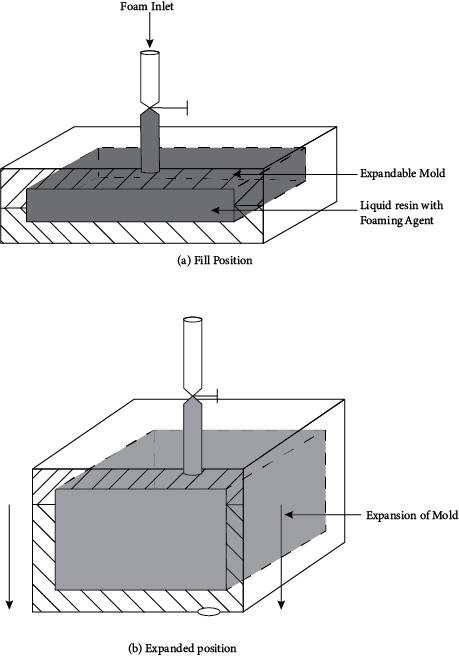
Figure 17.2 High-pressure foam molding.
An important process for foam molding is called reaction injection molding (RIM). In RIM, two reactive components are metered together and mixed inline so that they begin to react in either a polymerization or crosslinking reaction. (The RIM process, which is also used to make non-foamed parts, is described in more detail in Chapter 18.) To make a foam by the RIM process, a foaming agent is added to the resin stream and mixed in the inline mixer. This mixed resin material is then injected into a closed mold, where it begins to expand. By balancing the rate of resin injection and the rate of foam formation the mold will fill with a material of the desired density. This process is illustrated in Figure 17.3. The reactive nature of the resin components is the origin of the "reaction" part of the RIM name. The most commonly used resin for RIM is polyurethane, where the polyol is part A and the isocyanate is part B. In some cases, the foaming can occur by the reaction of the isocyanate with water to create carbon dioxide. Hence, the foaming agent can simply be water, although other foaming agents can also be used.
In contrast to the low-pressure foam molding method, in RIM the injection of material into the mold continues as the foaming inside the mold also continues. Therefore, the expansion is against a constant pressure (the injection pressure) rather than a free expansion. Another difference is that the RIM process can be used to encapsulate an insert or a core, whereas the free expansion of lowpressure foam molding would not effectively surround such a barrier to expansion within the mold. When the core is a reinforcement such as fiberglass, the process is called structural reaction injection molding (SRIM). This process and a similar process called resin transfer molding (RTM) are discussed in detail in Chapter 19.

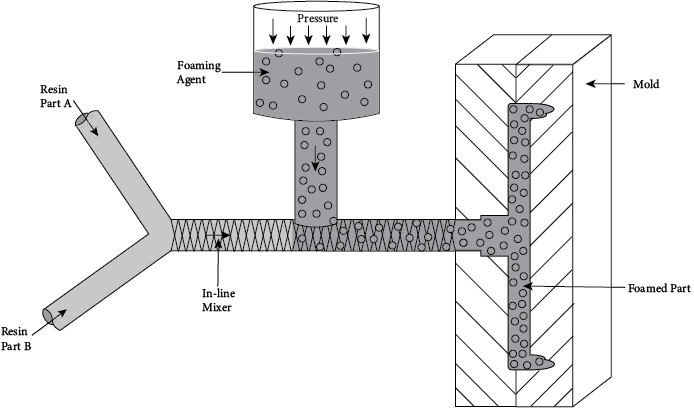
Figure 17.3 Reaction injection molding (AIM) foaming method.
Another foam molding process is called foam-in-place. As in RIM, the foam is injected into a cavity at a rate that balances the foaming of the material in the cavity and the injection rate. This balance gives the proper foam density. The difference between foam-in-place and RIM is that in foam-in-place the materials that make the foam usually don't react as the foam is being made. Foam-in-place is used to insulate between the walls of a refrigerator by injecting the foam between the joined inner and outer walls. The foam simply solidifies in place. This method allows sequential assembly steps, including the wiring of lights and other devices within the refrigerator walls, then joining of the inner and outer walls, and finally the injection of the thermal insulation foam. The ability to inject the foam after all the other steps have been done simplifies the assembly process. To facilitate the foaming into long, deep cavities, a foam-injection nozzle places the foam inside the cavity extremities (see Figure 17.4).

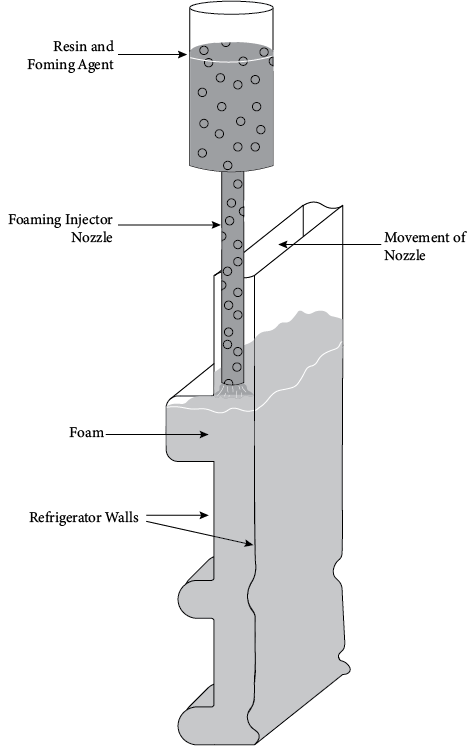
Figure 17.4 Foam-in-place technology used to insulate between the walls of a refrigerator.
17.3.2. Spray Foaming
In spray foaming, the resin and a foaming agent are mixed and then held in a pressurized bottle or in some kind of pressurized line. A propellant for carrying the resin and foaming agent may also be included in the bottle or line. The material is sprayed onto a surface to be coated with the foam by simply depressing the valve on the pressurized bottle or by actuating the trigger on the nozzle device (usually a spray gun) attached to the feed line. When the resin, foaming agent, and propellant are sprayed onto the surface of the item, the foaming agent causes the resin to expand freely. The propellant escapes into the atmosphere. Figure 17.5 illustrates this system for a spray bottle and Photo 17.4 for a spray gun.
17.3.3. Extrusion Foaming
Extrusion foaming is the same as normal extrusion except that a foaming agent is added in the extruder so that when the resin exits the extrusion die, it begins to expand. This expansion is controlled by some mechanical system such as conveyor belts spaced apart so as to give the desired density and final thickness. Paper or some other sheet material often is used as a conveying medium so that the foam will move easily between the conveyor belts. Paper can be used to limit the expansion on the top, bottom, and sides. The expansion therefore occurs inside a moving box.
An extrusion foaming system is illustrated in Figure 17.6. Extrusion foaming is principally used to produce flat foam slabs, such as the type used widely for building insulation panels. These slabs are cut off by a saw that is mounted on the conveyor line and that moves with the part so that the cutoff is square. The paper or other coating material can be removed on-line or shipped as a protective covering.

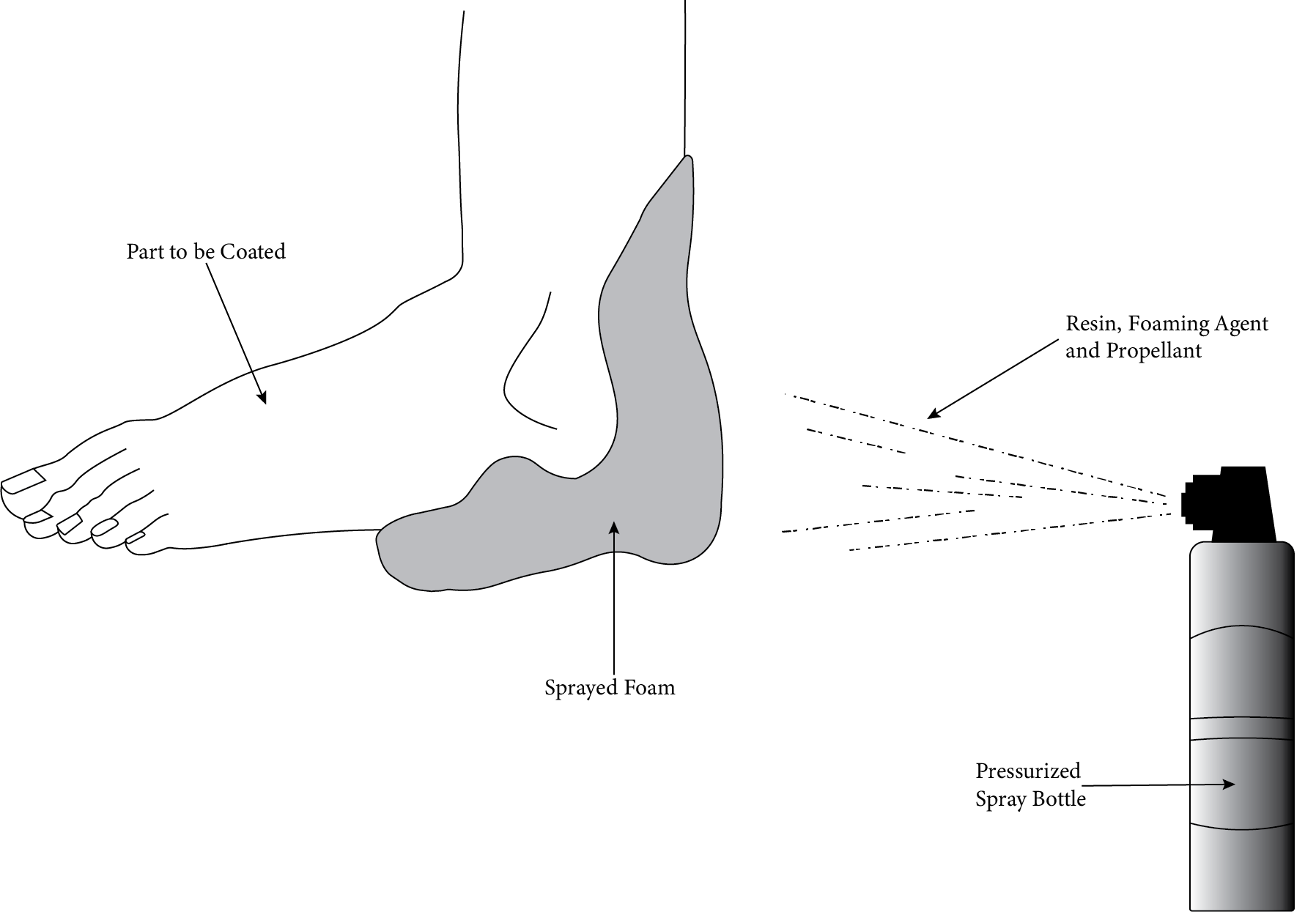

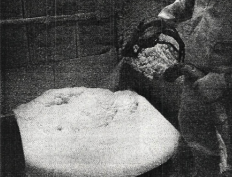
Photo 17.4 Sprayed foam insulation (foam-in-place). (Courtesy of Utah Foam Products, Nephi, Utah)

Figure 17.6 Extrusion foaming.
Thin extrusion-foamed sheets have found a major application in the packaging industry, where they are thermoformed to create clamshell containers used for packaging eggs and fast foods. Egg cartons make use of the foam's cushioning and shock-absorbing nature; fast-food containers use the foam's thermal insulative capability. Extrusion foaming can also be used to put foam on the back of carpets. Photo 17.5 shows a clamshell package.

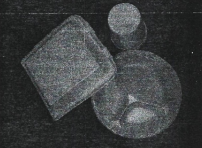
Photo 17.5 Foamed clamshell packaging, an example of a product made by extrusion foaming. (Courtesy of BYU)
17.3.4. Casting Foams
The process of casting foams differs from the other foaming processes because in casting no mechanical limit such as a mold or conveying system is placed on the foam's expansion. In the most common technique for casting foams, pan casting, a predetermined amount of resin and foaming agent are combined and then poured into an open pan. The foaming agent expands the resin, causing it to rise until the foaming agent has been spent. (This process is similar to the rising of bread dough in a bread pan where the dough is the resin and the yeast is the foaming agent that chemically produces the gas.) The pan casting method is illustrated in Figure 17.7. The resulting foam material is called a bun and has an integral skin that is denser than the rest of the foam. This integral skin is like the crust on a loaf of bread and is formed in both cases from the collapse of the cells on the surface of the foam when they touch a material that is different from the surrounding foam material. In this case the external material is the air. When the foam is cured by heating, the crust thickens because the heating causes cells just below the surface also to collapse.
The foamed buns are removed from the pans and then sliced or cut into the desired shapes. The most common shapes are slabs. This slicing or cutting is given a special name, skiving.


Skiving of foams is done with knives or saws, as with other plastic materials, but it can also be done conveniently with a hot wire. Typically, the wire is a high-resistance metal heated by simply running an electric current through it. The wire is held by a clamping mechanism that can be adjusted vertically to obtain various slab thicknesses. The bun is then moved against the wire slowly so that the wire melts the foam. As the bun is moved past the wire, a foam slab is separated from the rest of the bun. This process is illustrated in Figure 17.8 and in Photo 17.6.

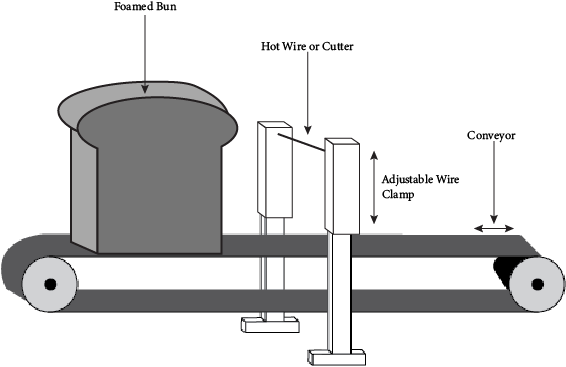
Figure 17.8 Skiving a foamed bun using a hot wire.

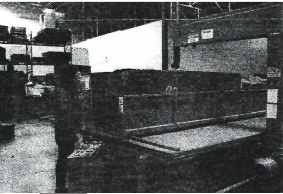
Photo 17.6 Cutting a foam bun. (Courtesy of Marko Foam Products, Inc., Salt Lake City, Utah)
17.3.5. Expanded Foam Molding
Although all foaming processes can be considered expansion processes because resin volume expands, one process in particular is called expanded foam molding, or expandable bead molding, and has some unique characteristics not present in the other foam-shaping processes. The expanded foam molding process (see Figure 17.9) is of particular importance in making polystyrene foam articles and is illustrated using that resin as an example.
The basic starter material for the expansion process is polystyrene that has been simultaneously foamed and polymerized by placing styrene in a solution of water and an organic volatile solvent such as pentane. In this environment, the polymer forms small spheres or beads of foamed polystyrene with the volatile solvent trapped inside the small, closed cells. The beads are approximately 0.002 to 0.08 inches(0.05 to 2 mm) in diameter, roughly the size of a grain of sand. The beads are removed from the water and are dried. In this form, they can be shipped to the molders and stored, provided they are stored at relatively low temperatures (below room temperature), which will largely prevent the volatile gas from escaping from the beads. However, some volatile gas is always present, so storage containers should be as airtight as possible and the storage facility should be well ventilated. (Caution: The storage facility should contain only nonsparking electrical equipment.)
The molder beginsthe actual expanded foam molding process by heating the beads so that they expand to about 20 times their original size, a step called preexpansion. Preexpansion is done by blowing hot air or steam through the tiny beads in an expansion chamber. The increase in temperature to about 212°F (100°C) causes the styrene to soften and volatilizes the trapped solvent. The gaseous solvent expands because of the heating and pushes out on the softened polymer, thus enlarging the spheres (beads). The size of the expanded beads is determined by the temperature and the amount of time they are left at the elevated temperature. Photo 17.7 shows the preexpanded and expanded beads. By preexpanding the beads before molding, the molding is much more uniform and predictable than it would be if the beads were molded and expanded simultaneously. Attempts to mold and expand the beads result in some sections of the molded parts having poorly expanded beads because heating is often less uniform within the confines of a mold than in the relatively open environment of an expansion chamber.

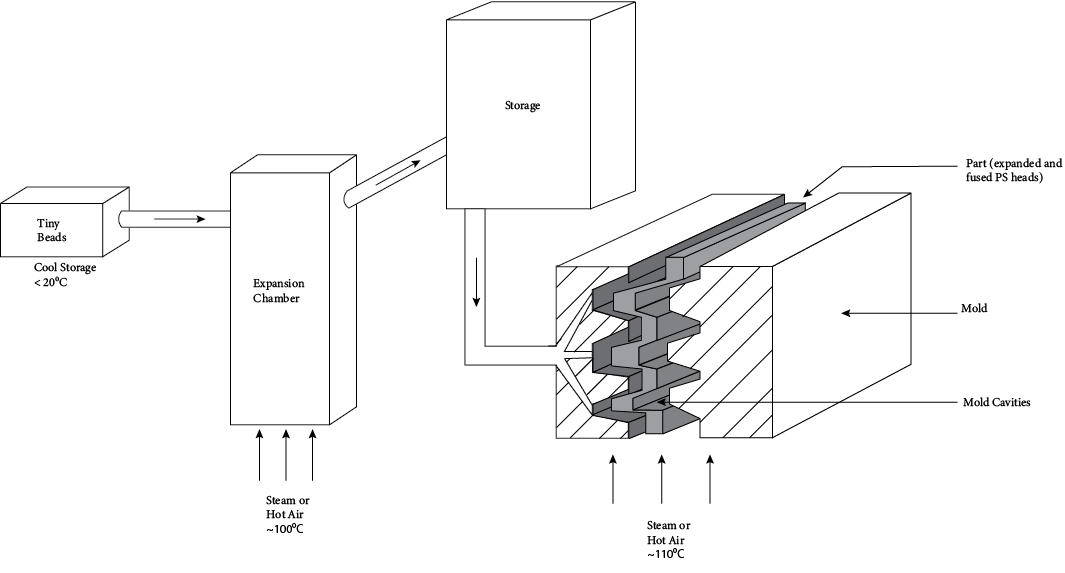
The expanded beads, roughly the size of apple seeds, are stored for about 8 hours to allow the internal pressure to equilibrate with atmospheric pressure. Some of the volatile gas will inevitably escape during this storage period. Since a small amount of internal gas retention is required for the subsequent molding operation, storage time should not be so long that all of the volatiles escape from inside the beads. Storage at room temperature for up to a week has proven to be acceptable. Expanded beads are used for other applications besides molding, one example of which is as filling material in beanbag chairs.
Molding of the expanded beads is done by conveying the beads to the mold area and blowing them into the cavities of a closed mold. After the cavities are filled, hot air or highpressure steam is blown through the cavities such that the temperature of the beads reaches about 212° to 220°F (100° to 110°C). At these temperatures, the styrene again softens and the residual volatile solvent expands, further enlarging the beads. Because the beads are confined in the cavities, the softened particles press together and eventually fuse to become a single mass of connected beads. If done properly, the fusion of the beads is such that all holes (pores) between them are sealed by the softened resin. The parts are then cooled by blowing cool air or water through the mold or by running cool water through cooling pipes within the mold body. The mold is then opened and the parts removed. (The machine that holds, opens, and closes the molds is much like the hydraulic system and mold-handling system of an injection molding machine.)


Photo 17.7 Expanded polystyrene beads as shaped and then after expansion. (Courtesy of Marko Foam Products, Inc.)
The expanded foam molding process is used extensively for making drinking cups, ice chests, and packaging. Careful examination of the products reveals their bead nature. Photo 17.8 shows products made using expanded polystyrene (eps) foam.